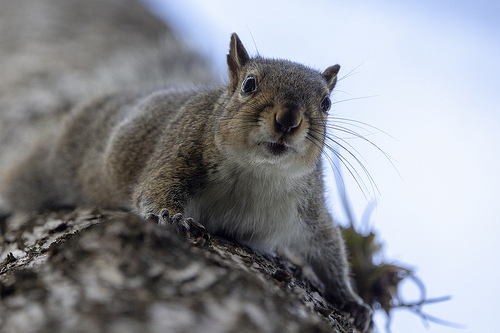How to Identify Orphaned Raccoons and Squirrels
by Ontario SPCA and Humane Society | Wildlife Fact Sheets | March 19, 2019

It is easy to mistakenly think that young squirrels and raccoons have been orphaned when a parent is in fact, still caring for them. If the young are removed in these cases, they have essentially been ‘kidnapped.’ Unless you are certain that the parent has been killed, it is best to take steps to make sure the parent is gone prior to taking the young from the nest or den site.
Even if you find animals on their own, away from the den site, it is best to attempt to reunite them with the parent because the natural parent provides the best care. Again, please remember to always wear gloves if you are going to handle wild animals, including babies.
Raccoons
Young raccoons should be placed in a cardboard box with the flaps folded closed securely. Folding the flaps over top of each other will keep the young animals inside the box, but will still allow the mother to open the box if she returns for the young. A disposable hot water bottle wrapped in a towel should be placed in the box to act as a heat source and the box must be left out overnight. A hot water bottle can be made from an empty plastic bottle, filled with warm water, wrapped in a towel and secured to the box with duct tape so it does not roll around. The box should be left as close as possible to the original location where the young animals were found.
If the young are found early in the day, they should be kept in the box somewhere warm, quiet and dark (i.e. shed or garage) until dusk and then the hot water bottle can be replaced with a new one to add more warmth and the box can be placed outdoors. Raccoons are active during the evening hours – and although it may sound uncaring to leave the young out overnight – this is the time that a mother raccoon will return if she is able to do so. She will not come for her young during the day so it is essential to leave them out overnight! DO NOT FEED THE BABY RACCOONS. If they are vocalizing for food it will help their mother find them. If the young raccoons are still in the box the next morning, contact your local wildlife rehabilitator for next steps.
Squirrels
Young squirrels should also be given the opportunity to reunite with their mother if there is any chance that she is still available to care for them. Unlike raccoons, mother squirrels will retrieve their young during the day, but not at night. Young squirrels should be placed in a shallow, open box with a heat source, such as a hot water bottle wrapped in a towel. A hot water bottle can be made from an empty plastic bottle, filled with warm water, wrapped in a towel and secured to the box with duct tape so it does not roll around.
If the squirrel has fallen from a visible nest, the box should be placed underneath the tree in which the nest is located. If you are unsure of where the nest is located, place the box under a tree near where the squirrel was found that may provide some shelter from the elements (such as direct sunlight or rain). Try to keep neighbourhood pets and children away from the area. DO NOT FEED THE BABY SQUIRRELS! Leave the young squirrels in the box for five to six hours (or less time if it is late in the day and becoming dark) and watch from a distance or check back regularly to see if they have been retrieved. If the mother squirrel has not retrieved the young squirrels after five to six hours (or sooner if they are still in the box at dusk), contact your local wildlife rehabilitator for next steps.
Note: Whenever young mammals are found, an attempt should be made to reunite them with their parent(s). Parents provide the best care for young wildlife and when young are inadvertently removed from their parents, it decreases the likelihood that they will survive, even with expert human care. Each wildlife species has its own specific needs and requires specialized care to recover.
Categories
Testimonial
Three cheers for the volunteers!
Three cheers for the volunteers! Keep doing wonderful work, thank you!
